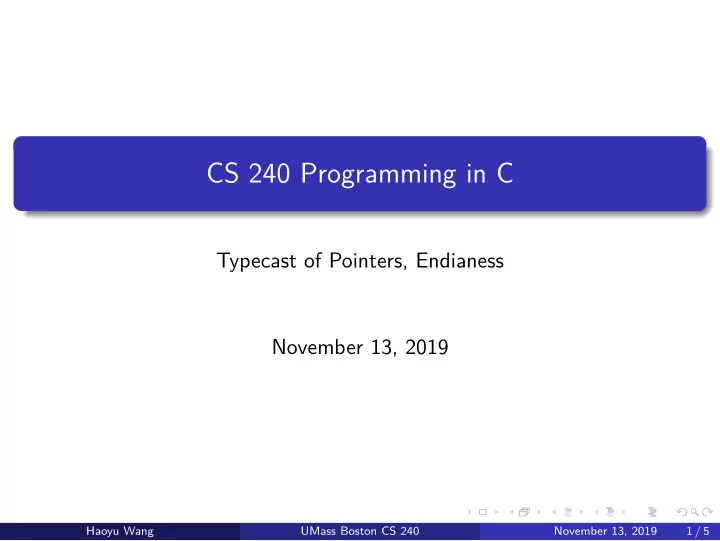

CS 240 Programming in C Typecast of Pointers, Endianess November 13, 2019 Haoyu Wang UMass Boston CS 240 November 13, 2019 1 / 5
Typecast of Pointers Pointer can be type cast to different pointer type. But it is prone to error if you do not understand what’s going on with them. For example: char s[] = "Hello"; int i = *(int *) s; char c = *(char *) &i; Haoyu Wang UMass Boston CS 240 November 13, 2019 2 / 5
Endianness 1 In computing, endianness refers to the order of bytes (or sometimes bits) within a binary representation of a number. https://en.wikipedia.org/wiki/Endianness 2 Big Endian Byte Order: The most significant byte (the "big end") of the data goes first 3 Little Endian Byte Order: The least significant byte (the "little end") of the data goes first. For example: short i = 0x1234; In memory: Big endian of byte order: [0x12,0x34] Little endian of byte order: [0x34,0x12] Haoyu Wang UMass Boston CS 240 November 13, 2019 3 / 5
Endianness 1 Historically, various methods of endianness have been used in computing, including exotic forms such as middle-endianness. 2 Today, however, big-endianness of byte is the dominant ordering in networking protocols (IP, TCP, UDP). 3 little-endianness of byte is the dominant ordering for processor architectures (x86, most ARM implementations) and their associated memory. Haoyu Wang UMass Boston CS 240 November 13, 2019 4 / 5
Direct input and Output Functions size_t fread(void *ptr, size_t size, size_t nobj, FILE *stream) size_t fwrite(const void *ptr, size_t size, size_t nobj, FILE *stream) size_t is just unsigned long; size: data type size; nobj: the number of this data Haoyu Wang UMass Boston CS 240 November 13, 2019 5 / 5
Recommend
More recommend